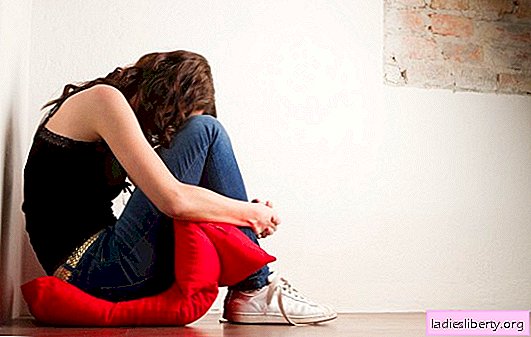
Often in the process of delivery, a woman is faced with tears and subsequent suturing.
Until they heal, the young mother should look after them.
Many women are often tormented by the question: what to do if sutures after childbirth hurt and is this the norm?
What to do if sutures after childbirth hurt? What are the seams?
By their location, they are divided into internal and external. There is also another type of suture that is applied after cesarean section.
Inseam
This type of suture is applied if there are tears in the walls of the vagina, uterus or its neck. The procedure is carried out immediately after birth. When sewing breaks in the walls of the vagina, local anesthesia is used.
When suturing, only self-absorbable threads are used that do not need to be removed.
Outer seams
This type of suture is applied during tears or incisions of the perineum. Doctors usually prefer artificial dissection if there is a high risk of rupture. It has smooth edges, unlike a gap, which means that the seam will heal much faster. The crotch is sutured under local anesthesia.
External seams can be applied both with self-absorbable threads and those that need to be removed 5 days after application. Also, not so long ago in gynecology, a cosmetic suture came from plastic surgery. Its difference is that the threads themselves pass under the skin, only the beginning and end of the seam are visible.
Seams after cesarean section
Caesarean section is far from uncommon in medical practice. An operation can be scheduled both scheduled and urgent. There are a lot of indications for cesarean, starting from the course of pregnancy, ending with the health problems of the mother. Emergency cesarean is prescribed in cases where natural delivery is out of control and there is a threat to the life and health of the mother or baby. Often with caesarean section cosmetic self-absorbable sutures are applied. They completely disappear after 60 days after application.
Sutures after childbirth hurt: how to properly care for them
While the young mother is in the maternity hospital, nurses are involved in suture processing. Usually, Zelenka or potassium permanganate are used for this. Sutures are processed 2 times a day. After discharge, the woman herself should do this for some time.
Why do you need to process seams? To avoid infection in unhealed wounds. Internal seams do not need processing, provided that there are no infections in the woman's body. To avoid unpleasant consequences, you need to take care of this during pregnancy.
But outdoor houses need to be processed after each wash.
In the first days after giving birth, one of the fears of young mothers is the urge to defecate. There is a risk that the seams will open. It is better not to strain once again and not to tension the fused tissues. If you want to use the toilet, it is better to ask the nurses to put an enema or a candle on a glycerin base.
The first time after suturing is necessary to wash after each trip to the toilet. You need to do this with clean water, and use baby soap or an agent for intimate hygiene only in the morning and in the evening. In order not to infect, you need to wash only in the shower and in no case in a basin of water.
While in the hospital, a woman should change the pad every 2 hours, at least. Even if it seems that she can still last an hour or two.
In the hospital and some time after discharge, you need to use underwear that is as breathable and free as possible. Now in any pharmacy you can buy disposable panties designed specifically for the postpartum period. If there are none, cotton underwear is suitable. Wear panties not immediately after a shower, but after a while.
Seams after cesarean section require more careful care. In the first week after birth, a young mother is generally not allowed to take a shower. The next few months, you can not use hard washcloths and rub the seam heavily.
Throughout their stay in the hospital, nurses also process the seams of the young mother. This is done at least twice a day, using antiseptic solutions.
Sutures after childbirth: what to do for quick healing
If you follow the rules for caring for stitches, you can speed up the healing process. In addition to regular processing, you need to remember that seams need air baths. The more often they are made, the faster they will heal.
When applying internal and external sutures, you can not sit in the next 2 weeks. Otherwise, the seams may part.
Slimming underwear is also contraindicated, as it is able to block blood flow, which will greatly interfere with the healing process.
Seams after cesarean section heal much longer. In order for this process not to drag out and go through without any complications, it is necessary to carefully monitor the condition of the seams, not to tighten them, and regularly process. It is important for a newly minted mother not to lift weights in the next few months after the operation. The maximum weight allowed is the weight of your own child.
Why do sutures after childbirth hurt?
About a month after giving birth, mothers often complain of pain in the suture area (moreover, no matter what). In most cases, this is a variant of the norm. However, there are several common causes of pain in the suture area:
● Frequent sitting and weight lifting. In this case, you can get rid of pain by excluding long sitting on both buttocks and limit the lifting of heavy objects.
● Constipation. This factor affects the soreness of the stitches placed on the perineum. The situation is especially common in the first month after childbirth. At this time, the formation of lactation occurs. All the liquid that mom drinks goes to the formation of milk. There is simply not enough fluid for a normal, soft bowel movement. Correct this is quite possible without the use of drugs and enemas. Just try to drink more fluids, especially warm milk, green tea, natural juices, and herbal infusions.
● Sexual contact. Often, sutures can hurt precisely because of a renewed sexual life. Dryness in the vagina creates an additional burden on the perineum. It is only natural that the sutures begin to hurt. You can reduce these discomfort with moisturizing gels. If discomfort in the seam area only bothers during intercourse, a change in posture can also help.
● Tissue inflammation. This scenario also happens, albeit infrequently. If, in addition to pain, redness and purulent discharge appear in the suture area, this is an occasion to contact a gynecologist soon.
● Postpartum discharge are an attractive breeding ground for microbes that cause inflammation. This provokes soreness of the seams.
Sutures after childbirth hurt: possible complications
Normally, pain in the sutures disappears approximately 2 weeks after the birth. If there was a cesarean section, then the period of pain can last up to a month. If after this time, the seams still bother the newly made mother with the pains, then you need to see a doctor. This indicates that something is interfering with the normal healing of the joints. It is not worth delaying an appeal to a gynecologist, since the consequences can be very serious.
Sutures after childbirth
If the examination of the sutures by the gynecologist does not reveal serious violations, then the doctor may prescribe heating. It is aimed at eliminating pain and accelerating the healing of sutures. Warming is carried out using an infrared, quartz or "blue" lamp, which is kept above the seam area at a distance of at least 50 cm. The whole procedure takes no longer than 10 minutes. She can be prescribed no earlier than 2 weeks after giving birth and only if the uterus has contracted.
If the seams have come apart
Although rare, this happens if the mother does not follow the rules of behavior and hygiene after suturing. If the discrepancy is already found at home, then immediately call a doctor. In this case, there are two scenarios:
1. After a thorough examination, the doctor will again stitch.
2. If the tightening process is almost completed, then no action will be needed.
If a discrepancy is found, you should not rely on the fact that the wound has already healed and you can do without calling a doctor. It can also be a complication in the next pregnancy and childbirth. It is better to play it safe and consult your gynecologist.
Itching and constriction
These symptoms are usually not signals of serious problems. If a woman experiences sipping in the area of the sutures or their itching (without redness), this only means that they are in the stage of active healing. This is a nice indicator. However, if these factors cause mom discomfort, you can contact a gynecologist and ask for an ointment to eliminate itching.
Suppuration
Absolutely all seams can fester: both internal and external, and after cesarean section. On the outside it will immediately become noticeable. But the decay of the internal seams will be characterized by unpleasant discharge of brown-green color. In any case, the appearance of pus is an alarming symptom with which you need to urgently consult a doctor. He can talk about divergence of sutures or infection. In both cases, medical intervention is needed. In case of infection, antibiotic injections are prescribed.
Bleeding
This situation is not uncommon and is often associated with non-compliance of the mother with the rules of conduct in the postpartum period. For example, if a woman begins to sit on both buttocks earlier than two weeks after suturing. Tissue tension occurs, the wounds are exposed and begin to bleed. Healing ointments usually help fix the problem. However, to calm down, it is better to consult a gynecologist and make sure that re-suturing is not required.
Every second woman after childbirth is stitched. To prevent gaps is almost impossible, however, it is really possible to reduce the chances of their occurrence. For this, a woman in childbirth must do everything in her power. First of all, obey your doctor and do not panic. During delivery, the entire process is controlled by an obstetrician-gynecologist, if necessary, he will make an incision.
If the seams were nevertheless imposed, the speed of their healing depends on the woman. Subject to all the rules, the sutures heal quickly and without much concern.











